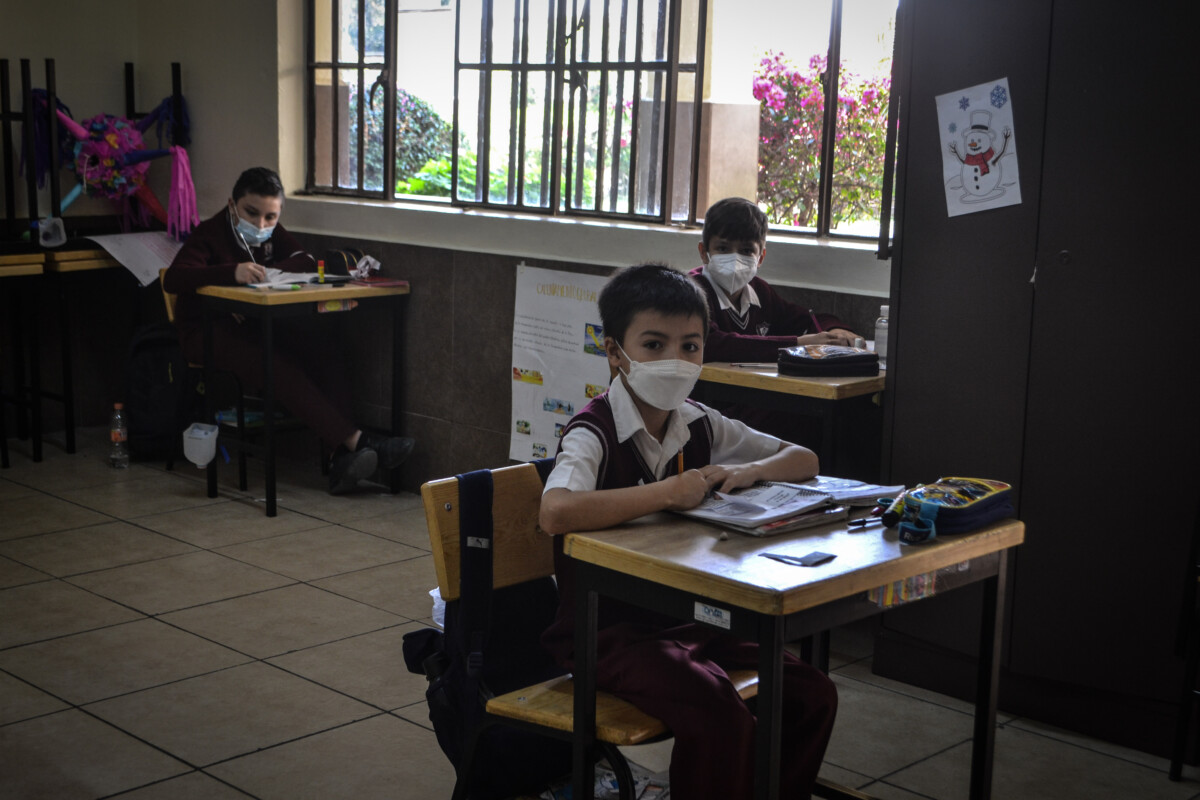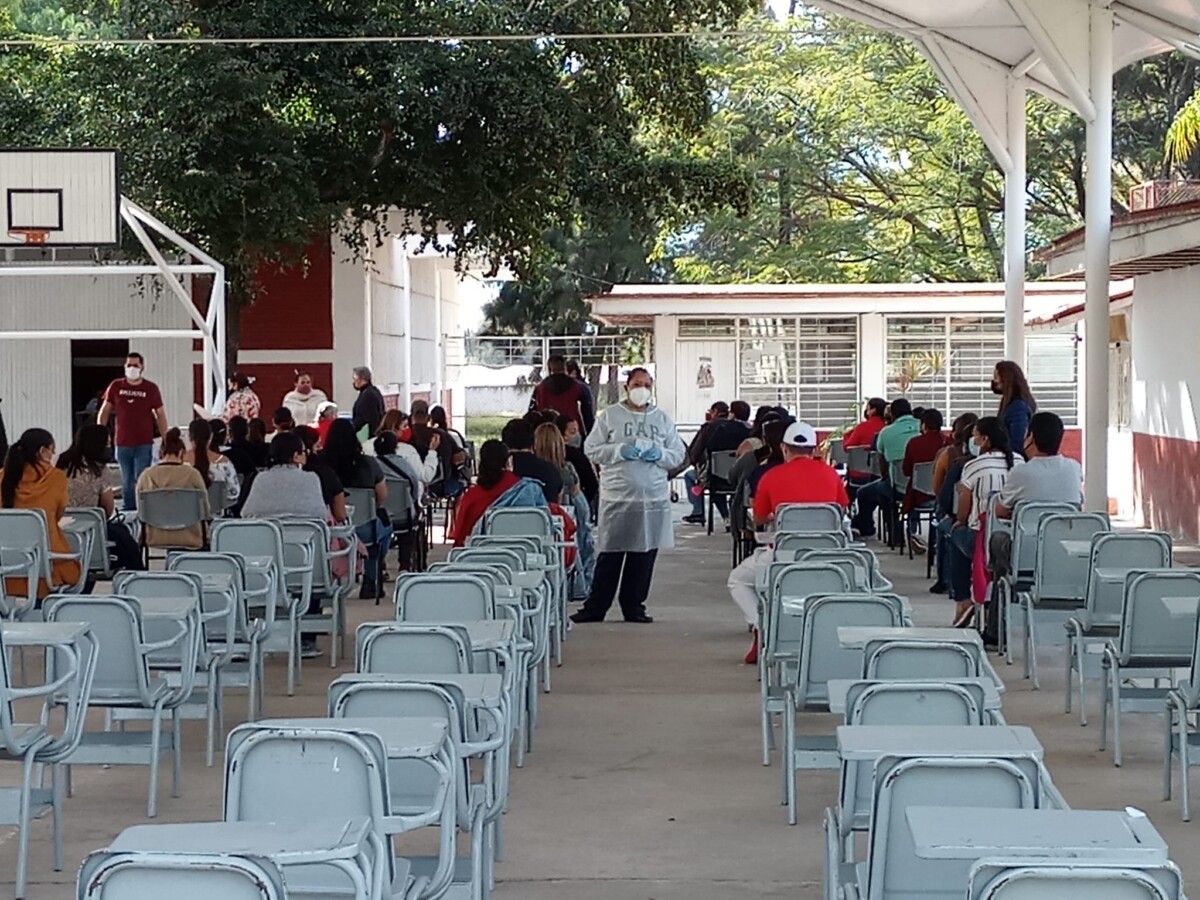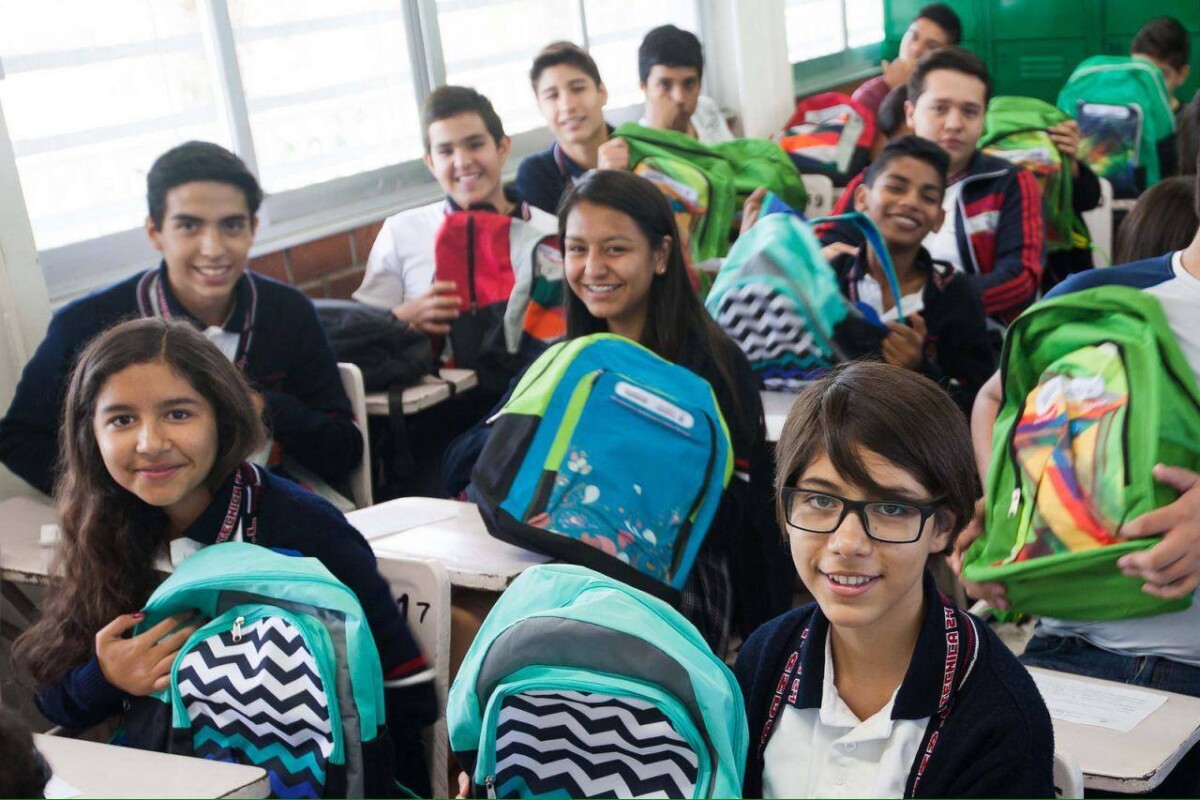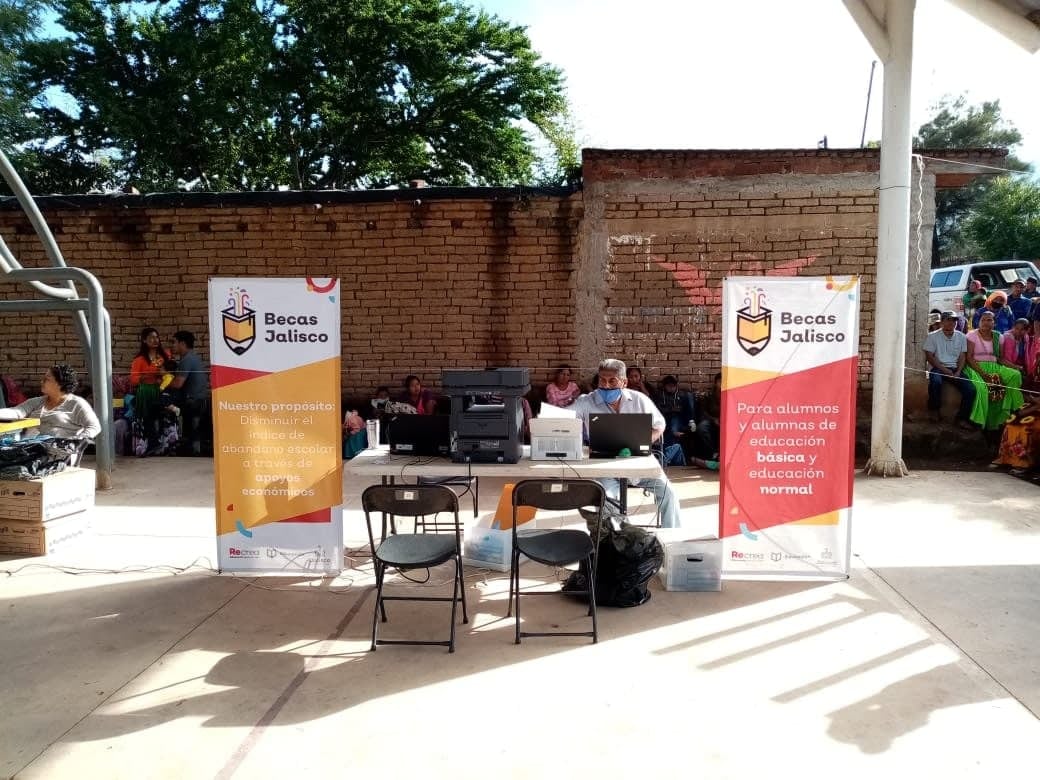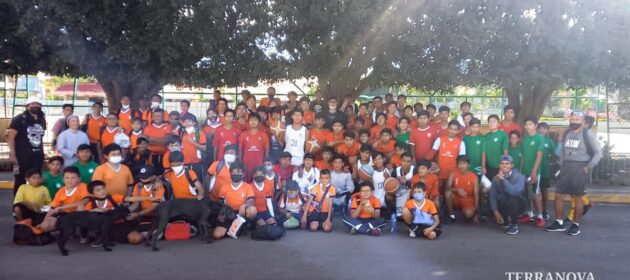educacion
Back to school classes start with a 70 percent overall attendance rate
J. Vicente Negrete School started its first back-to-school cycle with considerable absence of children and educational staff. Photo: Courtesy.
Héctor Ruiz Mejía: With approximately 30 percent non-attendance of students and educational personnel, basic education schools in the municipality of Jocotepec returned to classes.
After it was announced (despite the worrying increase in cases of coronavirus by the omicron variant) that this Monday, January 17, basic education schools in Jalisco would return to one hundred percent of their capacity.
According to educational personnel, classes started with an average of 30 percent of non-attendance by students and teachers in the different schools in the municipality of Jocotepec.
Educational authorities, who preferred to remain anonymous, say the main reason why most of the children have not returned to classes is because their parents are sick.
Although it was not specified if they were Covid-19 positive, as stated by the interviewee who is a teacher at Jocotepec School, this first cycle of return to classes, after almost two years of distance education, started with 25 percent of students’ non-attendance and one child confirmed positive for the coronavirus.
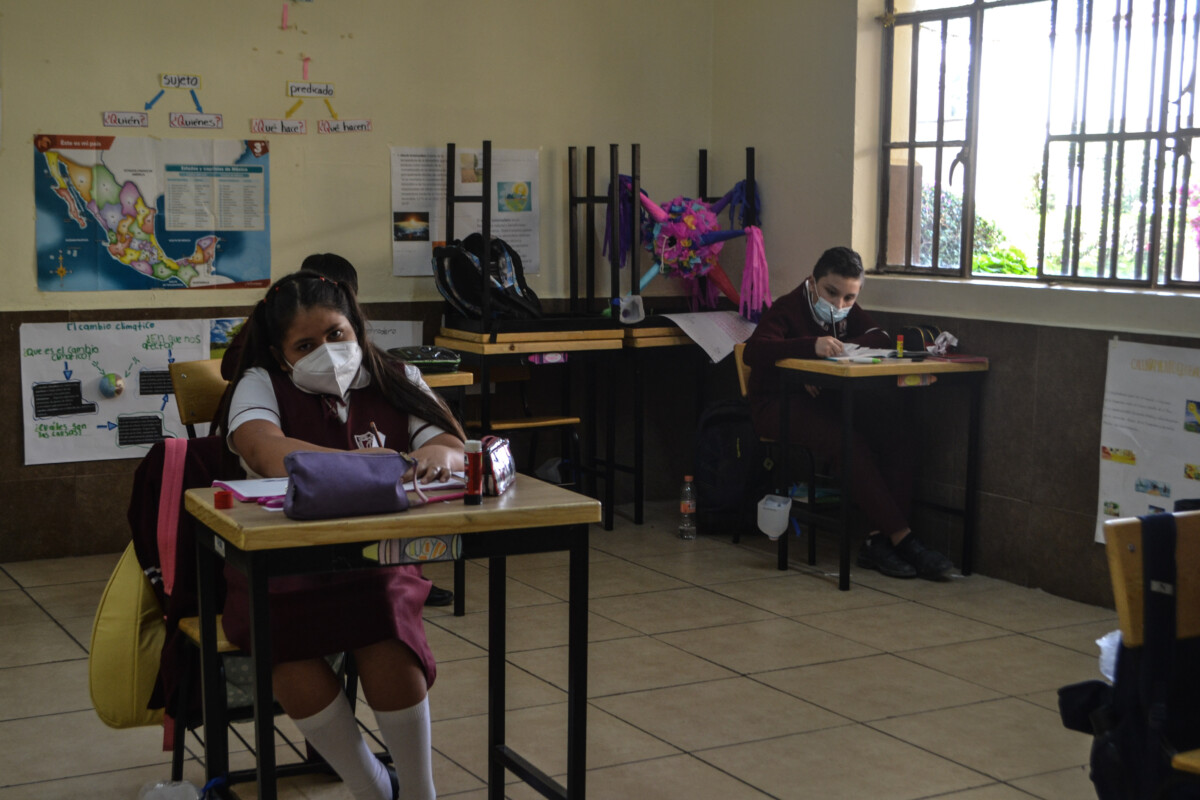
Parents worried about contagions after Señor del Monte festivities.
The interviewee said one student who was sent home that same day has been the only child (so far) who has tested positive for Covid-19, «the situation is worrying and even more so after all the festivities that have taken place.»
In addition, the teacher does not see the outlook for the next two weeks in a positive light, adding that «after the holidays the parents are the ones who are infecting the children,» she said.
On the other hand, the J. Vicente Negrete school began this first school year with a 30 percent absence of students, as well as 20 percent of the teaching staff being sick.
However, in order to protect the health of the entire educational community, without affecting the training and integral development of children and young people, the Jalisco State Government announced the implementation of the strategy «Covid-19 Random Test Application Model for Educational Personnel,» a measure to be carried out in schools that started on January 19.
This strategy consists of randomly applying tests to educational personnel in the 125 municipalities of the state, with the aim of detecting positive cases and isolating those affected in a timely manner, minimizing the risk of contagion and providing appropriate follow-up to each of them.
The Secretary of Health in the state, Dr. Fernando Petersen Aranguren, announced that, «in order to carry out these actions, the Secretary of Education of the Government of the State of Jalisco (SEJ) acquired 45 thousand tests that will be given y health personnel in the Health Regions of the state.
Translated by Sydney Metrick
Despite low attendance, Ajijic teachers find the students who return to class enthusiastic.
Santos Degollados High School, with its classrooms occupied by students.
Sofía Medeles (Ajijic, Jal.) – Although not all students returned to classes, and opinions about their presence are very divided, the principals of three schools shared that the students who returned expressed a great desire to be back in the classroom, given the loss in learning in class caused b y Covid.
In an interview for Laguna, Raúl Zamora Cárdenas, principal of Santos Degollado High School; Candelaria Castañeda, principal of Marcos Castellanos Elementary School; and Iván Ramos, principal of Francisco Márquez Elementary School, agreed there has been low turnout for the students but that they are enthusiastic to return to the classroom.
They commented that instructions for this return to classes were given by the Ministry of Public Education (SEP) and the Government of Jalisco, indicating that one hundred percent of the groups would be able to return with full health measures in place, although face to face attendance would not be mandatory.
«At the high school, there are two or three students missing per classroom, who have reported in as sick. Those who do not come to school in person participate through school WhatsApp groups. If someone decides not to come, they can use the RECREA platform to do their schoolwork,» asserted Director Raul, who added that it seems to him that the State Government does not take into account the needs of the schools, as there has been a lack of adequate financing to cover costs.
Principal Iván commented that, in the case of his school only 49 percent in attendance, approximately 101 students, while six percent of the absentees chose to take part in distance education.
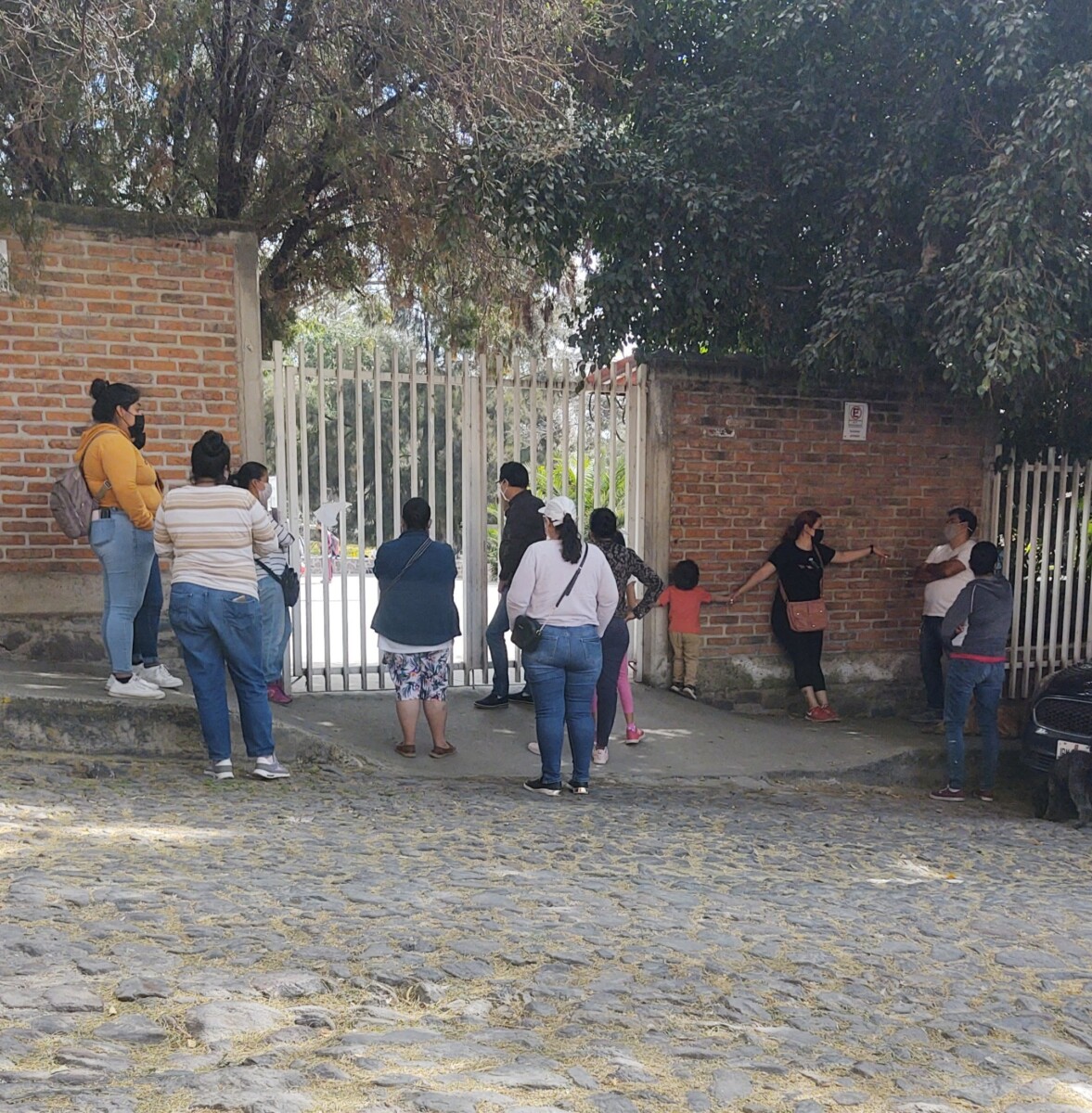
Parents exiting Francisco Márquez Elementary School. Students left in small groups to avoid crowding.
«Those who do not attend have close family members who are ill, so, to reduce risks, they themselves decided not to come. They are given the option of distance education, with the understanding that they are the same activities that are done in the classrooms, with small modifications to make it easier for parents and students. We prefer this to RECREA, since all parents find the platform difficult to use,» said Ramos.
Meanwhile, at Marcos Castellanos Elementary School, teacher Mrs. Candelaria reported that of the 210 students in the institution, approximately 150 students are currently attending, and the number continues to rise.
«The first day we had very low attendance, approximately 77 students. On Tuesday attendance increased, reaching groups of up to 30, and the following days the number has continued to increase. The missing students report as sick, but we continue to work at school with the usual health measures.»
Regarding the loss of learning and achievement by the students, all those interviewed confirmed it had occurred. Although the teachers were sympathetic, they commented on the lack of material or resources of some students to follow online classes, the lack of support from the teachers that is given in face-to-face, little space and time for the parents to assist their children, among other reasons. However, based on the comments from their students, they affirmed that the children are happy to return to classes. «They are very eager to return. They are enthusiastic. At school they like to be in class and with their friends, but yes, they go home, and suddenly they are upset because of their parents’ comments that they are behind in their learning,» added Mrs. Cande.
Principal Raul commented that this form of schooling will prevail for the rest of the school year, and that at the end of the school year the school will be given new instructions for operating. The three teachers thanked the parents for their help in monitoring their children for possible contagion and informed them that they are still working, and as far as possible, they are trying to be risk-free.
Translated by Colleen Beery
In Jocotepec, many teachers could not be vaccinated because of COVID-19 symptoms
Medical personnel from the Jocotepec Health Center, who were in charge of this vaccination day, confirmed that a considerable percentage of those vaccinated were from Guadalajara
Héctor Ruiz Mejía – The return to basic education classes has presented a new challenge, since a considerable percentage of teachers in the municipality of Jocotepec could not be vaccinated because they arrived with cold symptoms and were suspected to have contracted Covid-19.
Although a total of 2,494 doses of the Moderna biologic were applied during the last vaccination day for teachers on January 12, out of the approximately 3,000 doses available, most of the vaccinated teachers were NOT from Jocotepec.
Medical personnel from the Jocotepec Health Center, who were in charge of this vaccination day, confirmed that a considerable percentage of those vaccinated were from Guadalajara.
They also pointed out that, although no figures were specified, there was a considerable percentage of Lakeside teachers who could not be vaccinated because they had symptoms, as in the case of the J. Vicente Negrete school, located in El Molino.
The principal of the school, Mayra Berenice, stated that at least 20 percent of her teaching staff did not return to classes, as they were sick and some of those had not been able to get vaccinated due to their illness.
Translated by Colleen Beery
Scholarship program benefits less than one percent of Jocotepec children
In Jocotepec alone, 9,100 children make up the basic education payroll. Photo: Courtesy.
Héctor Ruiz Mejía – Not even one percent of children in the municipality of Jocotepec benefited from the Jalisco Scholarship program, according to personnel from the Jalisco Ministry of Education (SEJ).
According to the SEJ, of the 12,106 scholarships awarded in 2021, only 106 went to children in the municipality of Jocotepec, representing just 0.84 percent of the total support granted to the state. In other words, of the approximately 9,100 children registered in the municipality’s basic education system, only 1.16 percent had access to the annual support.
The educational authorities of the lakeside municipality noted that this is a troubling situation, because although no precise data are available, they know from experience that there are many children who need support to continue or complete their studies.
Part of the problem, according to the municipality’s educational personnel, is that a considerable number of the applications do not meet the requirements and so do not qualify for the support. «We try to check that all the documentation is in order before passing it on to the person in charge, but in many cases the parents have failed to provide even proof of studies or proof of address,» said the representative, who preferred to remain anonymous.
Not meeting the requirements is one of the main reasons why the applications have been rejected. «We help with the processing of a thousand applications, however, for various reasons such as non-compliance with the paperwork, only 100 of these are approved» he explained.
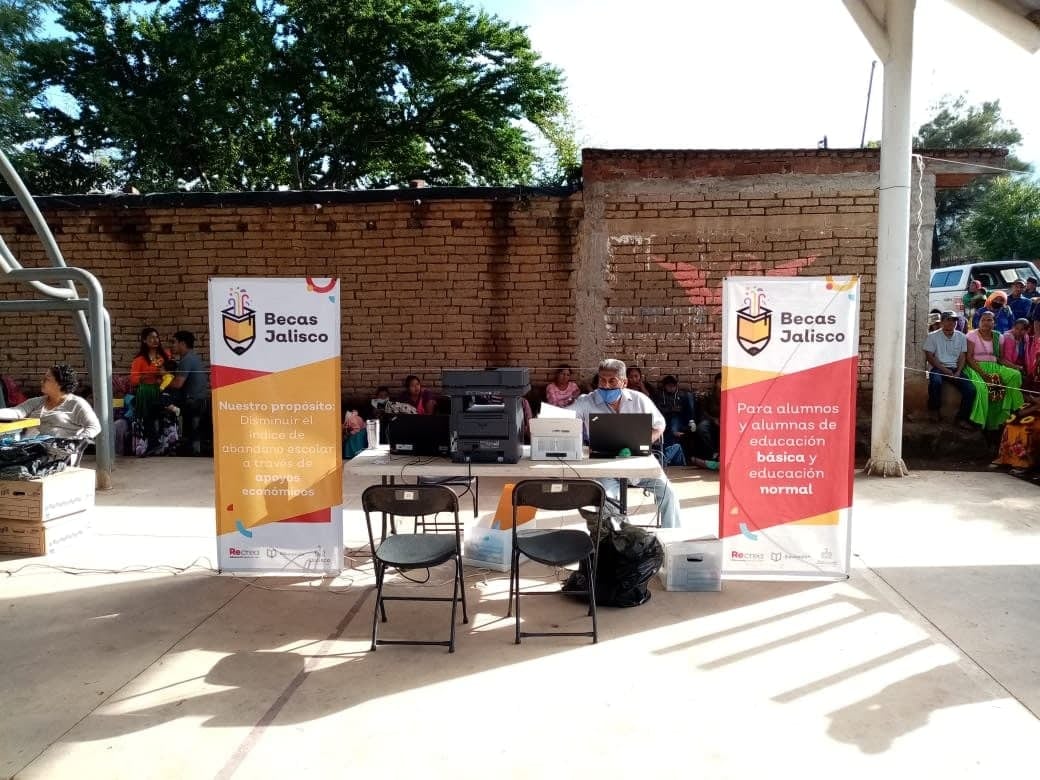
Education authorities regret the low percentage of children receiving economic support. Photo: Courtesy.
The representative also made it clear that the low budget allocated to education programs is an ongoing obstacle to providing adequate support to the children and young people who need it to complete their studies.
In his most recent visit to Jocotepec, Jalisco Director of Focus and Follow-up of the Ministry of Education (SEJ Fernando Lozano Morales met with municipal education authorities to speak about the situation. He acknowledged the precarious financial situation due to the federal budget cuts, but also reminded those present that Becas Jalisco (Scholarships Jalisco) is one of the few support programs to survive the cutbacks.
Furthermore, Fernando Lozano assured that despite current budgetary challenges, the amount allocated this year to the program will be triple the previous budget. This year’s goal is to provide access to funding for more families in a vulnerable economic situation in the lakeside municipality.
The Jalisco Scholarship Program was established as part of a strategy to prevent students from dropping out of school solely due to their families’ economic situation. The support consists of a one-time (annual) payment exclusively for children in basic education; funding is available for 1,800 students for the period January – June, and for 1,200 students for the period September – December.
Translated by Rebecca Zittle
Poco presupuesto para el apoyo de becas para educación básica en Jocotepec
Lamentan autoridades educativas el bajo porcentaje de niños beneficiarios del apoyo económico. Foto: Cortesía.
Héctor Ruiz Mejía.- No alcanzó ni el uno por ciento de niños beneficiarios por el programa Becas Jalisco en el municipio de Jocotepec, aseguró personal de la Secretaría de Educación Jalisco (SEJ).
De acuerdo con la SEJ, de las 12 mil 106 becas que se otorgaron en el año 2021, solo 106 fueron destinadas a niños del municipio de Jocotepec, esto representó el 0.84 por ciento de todo el apoyo otorgado para el estado.
Es decir, de los aproximadamente 9 mil 100 niños registrados en la planilla que conforman la educación básica en el municipio de Jocotepec, solo el 1.16 por ciento tuvo acceso al apoyo anual.
Las autoridades educativas del municipio ribereño aseguraron que es una situación preocupante, pues, aunque no se especificaron cifras concretas, hay muchos niños que necesitan apoyo para continuar o concluir sus estudios.
Sin embargo, a decir del personal educativo del municipio, una parte considerable de las solicitudes no cumplen los requisitos y no son vinculantes para los apoyos. “Nosotros tratamos de revisar que esté en orden toda la documentación para entregarla al encargado; sin embargo, en muchos de esos casos los padres no traen ni siquiera la constancia de estudios ni el comprobante de domicilio”, aseguró el entrevistado, que prefirió mantener el anonimato.
No cumplir con los requisitos es una de las principales causas de que las solicitudes hayan sido rechazadas, “nosotros ayudamos con el trámite de mil niños, sin embargo, por varias razones como tal incumplimiento de papeleo, solo 100 son aprobados”, explicó.
También, aseguró el entrevistado que el poco presupuesto destinado a los programas de educación ha sido un obstáculo para brindar el apoyo adecuado a los niños y jóvenes que lo necesitan para concluir sus estudios.
No obstante, en su última visita al municipio de Jocotepec, donde se reunió con autoridades educativas municipales, Fernando Lozano Morales, director de atención y seguimiento de la Secretaría de Educación Jalisco (SEJ), se pronunció al respecto de la situación. Reconoció la precaria situación sobre el recorte presupuestal federal y recordó como Becas Jalisco es uno de los últimos programas de apoyo que sobreviven por dicho recorte.
Además, Fernando Lozano aseguró que, pese a los retos presupuestales, este año se triplicará el monto utilizado por el programa con la intención de poder acceder a más familias del municipio ribereño en situación vulnerable económica.
El programa de Becas Jalisco es un programa que se estableció como estrategia para compensar las carencias que viven muchos alumnos en situación económica vulnerable y así, evitar que abandonen sus estudios.
El apoyo consta de un pago único (anual) exclusivo para niños de educación básica de mil 800 para los solicitantes del periodo enero – junio y la cantidad de mil 200 para los estudiantes del periodo septiembre – diciembre.
Planea Secretaría de Educación Pública alinear la educación en los municipios
Fernando Lozano Morales, director de Atención y Seguimiento de la Secretaría de Educación Jalisco en la reunión con autoridades municipales de la ribera. Foto: Cortesía.
Héctor Ruiz Mejía.- Buscará la Secretaría de Educación Jalisco (SEJ) digitalizar al cien por ciento la educación en el estado, incluyendo a los municipios como Jocotepec.
Para esto, explicó Fernando Lozano Morales, director de Atención y Seguimiento de la Secretaría de Educación Jalisco, se buscará adquirir 500 Chromebooks más de las 500 con las que actualmente cuenta la dependencia educativa.
Para esto, los diputados locales avalaron la Ley de Ingresos 2022, donde se aprobó el incremento desde el dos hasta el 2.5 por ciento el Impuesto Sobre la Nómina (ISN) a cubrir los empresarios, como reportó UDGTV.
Dicha medida, la cual prevé impactar unas 130 mil empresas, tiene estimado recaudar unos 800 millones de pesos para conformar un Fideicomiso para la Infraestructura Educativa 2022, el cual estará destinado para completar la cantidad de mil Chromebooks para este año.
No obstante, las mil computadoras de Google destinadas a diferentes planteles educativos, conformará solo el aproximadamente diez por ciento, pues de acuerdo con Fernando Morales, simplemente en el Estado de Jalisco, persiste un padrón de escuelas de 11 mil 400 (contando los dobles turnos) distribuidos en siete mil 400 escuelas, por lo que tomaría alrededor de siete u ocho años digitalizar por completo a las escuelas del Estado.
Así, en la reunión del martes 11 de enero en el municipio de Jocotepec, entre autoridades educativas (en representación de Juan Carlos Flores Miramontes, Secretario de Educación Jalisco), de autoridades de los municipios de Jocotepec, Acatlán de Juárez, Tizapán, así como San Martín de Hidalgo y la diputada por el Distrito 17, ‘Lolis’, discutieron la nueva reforma educativa.
La nueva estrategia con el nombre de RECREA, aseguró Fernando, tiene como objetivo el combatir el rezago educacional, el cual señaló, ya no son las personas mayores, sino los jóvenes de 17 a 27 años que no han podido concluir ni la secundaria.
Se tiene planeado implementar el nuevo sistema Comunidades de Aprendizaje para la Vida (CAV), el cual capacite a los directores y maestros en temas como ‘liderazgo’ y tecnología, pues se pretende ya no cometer los mismos errores.
Pues recordó como anteriormente, con pantallas digitales didácticas, al no contar con maestros capacitados para usarlas (y darles mantenimiento), terminaron siendo simples proyectores para presentaciones de Power Point.
Así también, dentro de la presentación de la nueva propuesta educativa, autoridades municipales expresaron sus dudas respecto a los lineamientos para la adjudicación del sistema Becas Jalisco, pues aseguró Oscar Zambrano, director de educación en el área (DRSE), de los 500 niños que exitosamente registraron, solo se adjudicaron 50 becas.
Fernando explicó que, una de las principales razones es el recorte presupuestal que se hizo desde la entidad federativa, y que el programa de Becas Jalisco es uno de los pocos programas que sobreviven tras la falta de presupuesto.
Por lo que recalcó la importancia del aumento al presupuesto y aunque hasta el momento, se desconoce la cifra que se destinó para Becas Jalisco en el 2021, aseguró que para este año el monto aprobado para becar a los niños del estado se triplicó.
The Terranova Institute inaugurates the first school tennis court in Lakeside
The facilities were inaugurated in December with a ribbon cutting in which authorities from the Ministry of Education Jalisco, the City Hall and the educational institution itself participated.
Editor. – The Terranova Institute of Ajijic inaugurated the first tennis court in an educational institution on the shores of Lake Chapala with a religious mass, a ribbon cutting and a demonstration match played by its students.
The sports facilities were inaugurated during the month of December and will be used by students who decide to take up this sport as part of the optional subjects in their academic offerings.
During the inauguration the administrative director, Salvatore Blum, emphasized that with tennis the institution will now have five sports disciplines for the students, as part of the comprehensive education they receive so that they can achieve the best version of themselves through discipline, perseverance and teamwork.
The inauguration was attended by educational authorities from the Secretary of Education of Jalisco in the region, as well as representatives of the Chapala City Hall and benefactors of the educational institution, in addition to students and teachers of the school.
Translated by Patrick O’Heffernan
Opinion: Breathing
By Leticia Trejo
Dear readers of Semanario Laguna, this introduction gives me the opportunity to share with you something I tell my students in my yoga classes: Welcome all bodily sensations, comfortable and uncomfortable. When we begin the process of returning to physical activity after many years of not doing anything with discipline and constancy, it is common for our bodies to ache. Muscles and joints that for years have not received the special attention of self-care do not recognize the activity and respond by manifesting pain.
Another common sensation is shortness of breath. We try to follow the new routine – whether it’s twenty minutes on the treadmill or elliptical, a yoga or spinning class, or a tennis match – whatever activity we choose to get moving again represents an effort that feels enormous. And of course, the most important muscles for any routine, or extra-ordinary, activity of the day are now shrunken, shortened and atrophied.
At the risk of making this sound too technical, there are muscles that we should know about, and one of these is the diaphragm. The diaphragm is the most important muscle for respiration, responsible for seventy-five percent of the total function of taking in oxygen and removing toxins and carbon dioxide from the body. So if you, like me, thought it was the lungs that deserved all our attention, you now have more accurate information on how to help the lungs perform their important functions.
To be more precise: the lungs do not function without the work of the diaphragm. To give you a clearer picture, this muscular structure lives inside the ribcage; it is mushroom-shaped and acts like a parachute, filling with air when you inhale and collapsing when you exhale. It fills the entire circumference of the ribcage, and as it moves it massages the heart, the lungs, and the esophagus – the valve that prevents gastric juices (acids) from going up into your throat from your stomach. As if that were not enough, it is responsible for you being able to climb stairs without getting tired, or climb a hill without gasping, as well as for reducing or eliminating one of the most uncomfortable and annoying activities that some of us engage in: snoring. How does it do that? -When you learn how to prepare it, train it, and strengthen it, thereby making it more elastic.
An alarming fact is that, out of all the capacity of this important muscle, most people use only two percent. It can extend a total of ten centimeters, but ninety percent of people cannot make use of their diaphragm’s full capacity due to weakness or deterioration of this muscle. To phrase it in stark perspective, if ten centimeters of capacity equals one hundred percent life, then two centimeters would be eighty percent death. I don’t want to be dramatic, but I see it every time I train or teach someone who has years of not moving everything, and everything is extremely difficult for them.
There are special exercises to work this muscle and to achieve its maximum capacity. My most important advice in this column is: before forcing yourself to do intense physical activity, first train the diaphragm.
And as an extra gift I give you one more important fact: fat is not “burned,” and sweat is not fat. Fat goes through an oxidation process that turns it into vapor and liquid that come out through urine, feces and exhalation. A strong and elastic diaphragm will bring in a large amount of oxygen which will decrease your visceral fat levels, and visceral fat is the fat that surrounds your organs such as your heart, liver, kidneys, etcetera. A strong and elastic diaphragm will help eliminate a lot of fat, among other toxins. So if you really want to get in shape, take this information to heart! See you next week with more wellness tips.
Translated by Rebecca Zittle
Opinión: Salud y Bienestar en la Laguna
Por Leticia Trejo
Cuando le pregunto a las personas, ¿qué es estar en forma? Generalmente me dan una imagen de una persona con características como buen cuerpo, un vientre atractivo, buena postura corporal, dinámico, lleno de energía, entre otras. En realidad me están describiendo a una persona Fitness, que va al gimnasio todos los días, que hace una dieta estricta y que tiene metas de una estética corporal perfecta.
Al paso de los años me doy cuenta, entre personas contemporáneas de mi edad, que estar en forma es algo más que verse estéticamente perfecto. Me doy cuenta que ser capaz de sentir alegría, dormir bien, despertar descansado, respirar plena y profundamente, sentir agradecimiento y demostrarlo, ser capaces de ofrecer ayuda y no esperar nada a cambio ya son indicadores de estar en forma. Porque la vida es algo más que “verse bien”, aunque claro, tener atractivo físico es un regalo para todos, he comprobado que no lo es todo.
Entrando en el tema del Bienestar Físico, estar en forma es poder realizar las actividades funcionales del cuerpo humano:
Sentarse en cuclillas y hacer desplantes
Flexionar el tronco hacia adelante
Rotar la columna
Mantenernos erguidos sin esfuerzo
Empujar
Jalar
Avanzar (locomoción)
Estos movimientos equivalen a poder subir y bajar escaleras, poder subir y bajar de un automóvil, empujar objetos pesados, abrocharse las agujetas, tener la espalda sana, viajar y caminar por largos periodos de tiempo, jalar bolsas desde el piso y subirlas a un anaquel o voltear con agilidad para esquivar objetos. Preservar la movilidad de nuestras articulaciones y la fuerza muscular se vuelve muy relevante con la edad y también funciones como el equilibrio, la coordinación, la organización de los movimientos y su ejecución.
La sorpresa más grande que me llevé es que los expertos sugieren que empecemos a cuidar estas funciones a los 35 años para que al llegar a los 65 años de edad seamos adultos mayores independientes y autónomos, libres de la necesidad de que otros nos gestionen el tiempo y las actividades cotidianas. Las capacidades descritas en esta columna nos garantizan una vejez en plenitud en donde podamos seguir disfrutando de nuestros seres queridos, aportando valor a la familia, a los amigos y a la sociedad. Incluso si no tuvimos hijos y no nos queda familia con la cual convivir, conservar esta autonomía se vuelve más relevante, ya que está en juego la Dignidad Humana en la que somos capaces de valernos por nosotros mismos.
Gracias a la tecnología digital las herramientas para lograr ser adultos mayores inspiradores nunca habían sido tan accesibles. ¿Qué vas a buscar? Nombres como Moshe Feldenkrais, Mathías Alexander, Joseph Pilates, B.K.S. Iyengar, T.K.S. Desikachar, Therese Bertherat son algunos de los Maestros de Consciencia Corporal que cuentan con su propia metodología para que desarrolles una preparación física paulatina, gentil y amable contigo mismo para estar realmente en forma. Explora y recuerda la famosa frase de Sir Winston Churchill: el éxito es la capacidad de ir de fracaso en fracaso sin perder el entusiasmo.
Students from Terranova Institute and Villa de los Niños enjoy friendly competition
Photo: As part of the sports activities, students from both institutions played friendly matches in three sports disciplines
Editor. – Students from the Terranova Institute of Ajijic visited the Villa de los Niños, a Boystown located between Jocotepec and Guadalajara, where they held several friendly competitions and gave away a little more than 50 balls to the students of that educational institution.
There were a little more than 40 Terranova students with their sports teachers who played some friendly volleyball, basketball and soccer games.
During the visit, the students from the Terranova Institute were able to share a snack with each other to support and strengthen the ties between the two educational institutions.
The students enjoyed the activities in the company of the boys from the Villa and hope to return soon to continue their visit.
Villa de los Niños gives an opportunity to poor boys with an aptitude for learning to receive a good secondary education or vocational training. There is also a Villa de las Niñas near Mexico City.
Translated by Kerry Watson
© 2016. Todos los derechos reservados. Semanario de la Ribera de Chapala
